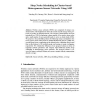81 search results - page 14 / 17 » Energy-Efficient Scheduling for Multiple-Target Coverage in ... |
CSE
2009
IEEE
13 years 10 months ago
2009
IEEE
A lifetime of several years for wireless sensor nodes can be achieved if their activity period is minimized. This can be done by using low duty cycle protocols. One of the challeng...
TMC
2010
13 years 5 months ago
2010
—To make a network last beyond the lifetime of an individual sensor, redundant sensors must be deployed. What sleep-wakeup schedule can then be used for individual sensors so tha...
SENSYS
2006
ACM
14 years 1 months ago
2006
ACM
Varying interference levels make broadcasting an unreliable operation in low-power wireless networks. Many routing and resource discovery protocols depend on flooding (repeated pe...
MASS
2010
13 years 5 months ago
2010
Wireless sensor networks typically conserve energy by following a periodic wakeup-sleep schedule: nodes minimize idle time and spend most of their time in a low power sleep state. ...
ICESS
2007
Springer
14 years 1 months ago
2007
Springer
Abstract. Wireless sensor networks (WSNs) are comprised of energy constrained nodes. This limitation has led to the crucial need for energy-aware protocols to produce an efficient ...

